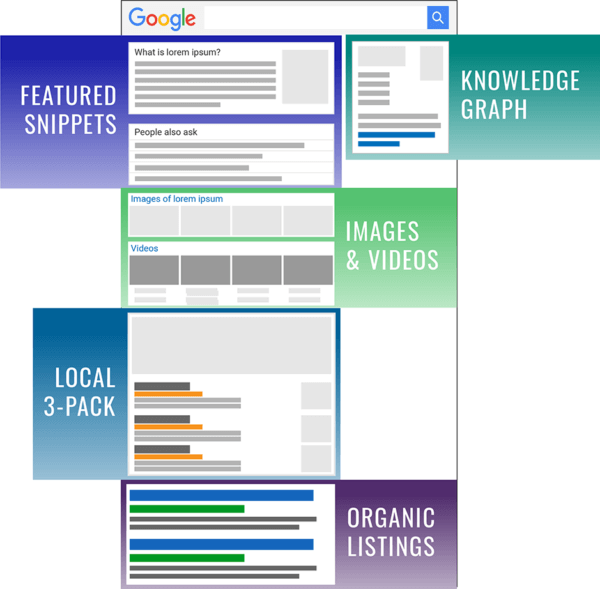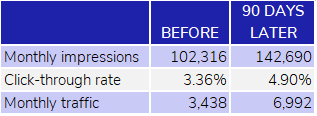When most people think of “content,” blog posts are usually the first thing that comes to mind, followed perhaps by ebooks, webinars, and other content pieces available to website visitors. But some of the most important content isn’t readable on your website: it’s the SEO content that gets traffic to your website.
The Challenge: Capture Real Estate on the Front Page of Search Results
Of course, one of the main goals of SEO has always been to capture the first search engine results page (SERP) to drive traffic to your website. But in recent years, it’s gotten tougher to do so, as search engines have “reorganized” their front pages to show different types of content.

Furthermore, Google in particular has pushed as much of its own content (from its extensive databases) as possible to the front page, sometimes knocking organic listings off page 1 (or several scrolls down on a mobile device) altogether.
So your SEO team has to be smart about capturing as much space as possible on the first page of the SERPs. That means consistent, strategic use of SEO content to entice new visitors to your website.
How to Get Traffic to Your Website by Capturing Prime Listings
Featured Snippets
These highlighted boxes are considered “position zero” in SEO, in that they’re even higher than ranking first in organic listings. Snippets can include paragraphs, numbered or bulleted lists, tables, and guides to more content, such as “People also ask.”
The most important thing to note about Featured Snippets is that they focus on answers to specific questions. Thus, the best way to capture Featured Snippets is to ensure that your on-page content answers questions from your customers or prospects succinctly and well.
Knowledge Graph
This mini-dossier appears in the top right column of the SERP, usually for brand searches. For recognizable companies and brands, this info is filled in by Google, so there’s not much you can do to capture this spot.
However, if your company is less well known or relatively new, you can directly influence the information that appears in the Knowledge Graph. First, claim and verify your company on Google My Business. Then optimize your listing:
- Be sure all information such as addresses (so you’ll show up on maps), business hours, phone numbers, and website URLs are accurate and up-to-date
- If your business has any reviews on Google, they will show on the Knowledge Graph, so be sure to respond to all reviews, negative and positive – but especially negative
- You can post short items on your main Google My Business page to give it more visibility; this is perfect for events, announcements, and links to your blog posts
Images & videos
Not only are videos and images often given their own space on the first page of SERPs, text from image and video descriptions can also land in featured snippet paragraphs, doubling the visibility of the result.
But first, relevant, informative descriptions must be there for your images and video. Image and video descriptions are one source of SEO content that often gets ignored, likely because images are considered “nice to have,” whereas text content is “have to have.”
Rich SEO content for images and videos means that:
- Every image on your website must, at least, have an alt tag stating what the image is. A blog post isn’t complete until the alt tag, description, and caption (if applicable) for every image in that post are complete.
- Every video on your website or posted to a video hosting service must have an SEO-rich description with keywords tagged. This is especially important for videos on YouTube, as the service is owned by Google, and thus has extra importance on Google listings.
Local 3-pack
Obviously, this SERP space applies to local searches, but if your company serves a local audience, it’s a good place to be. Only the top 3 listings show in the local pack, and their positioning is largely determined by volume of reviews and average review score.
The same optimization principles for Google My Business listings apply here, because that’s where the info for Local ranking comes from. However, reviews are the most important type of SEO content here, as there are only 3 spots available.
To increase your chances of appearing in the 3-pack, monitor your company’s reviews, respond quickly to them, and do what you can to right any wrongs cited in reviews. Also, ask happy customers to write your company a review on Google. Reviews are somewhat out of your control, but you can take steps to improve them over time.
Organic listings
Finally, at the bottom of the SERP, are the listings that have been a cornerstone of SEO content since the beginning. Just because these results appear lower on the page than “packaged” results such as Featured Snippets doesn’t mean they’ve diminished in importance.
Remember, the snippets don’t appear for every search query, and they don’t all appear for the vast majority of queries. As of 2017, research by Ahrefs indicated that only about 12.3% of all search queries had results that included a Featured Snippet. While that proportion has surely increased since then, it’s still under 50%.
So your organic listings are still one of the best ways to drive traffic to your website, and optimizing them is still essential. Meta content seems so basic that it’s taken as a given, but sometimes the basics can have the most impact.
Case study
A client in the educational space was missing out on organic traffic because their meta content wasn’t optimized:
- 26% of pages on their site had duplicate meta titles or none at all
- Meta titles weren’t aligned to keywords or on-page content
- 63% of pages had no meta description, including almost all blog posts
Their average CTR for organic queries was 3.36%.

After one month of implementing SEO content best practices, all their meta content was optimized:
- All meta titles had relevant keywords and were aligned with on-page content
- All meta descriptions were complete and had clear value statements and calls to action.
Two months later, the site’s average click-through rate for its organic keywords was 4.90%, a gain of 37.5% in just 90 days. Because organic visibility had improved during those 90 days as well, the total impressions for those pages increased by 39.5%. As a result, average monthly traffic had more than doubled.
So be sure to make SEO content part of your team’s overall content strategy. If you’d like to learn more about content strategy, or just discuss how SEO content fits into it, let’s talk about your content, your traffic, and your website.

